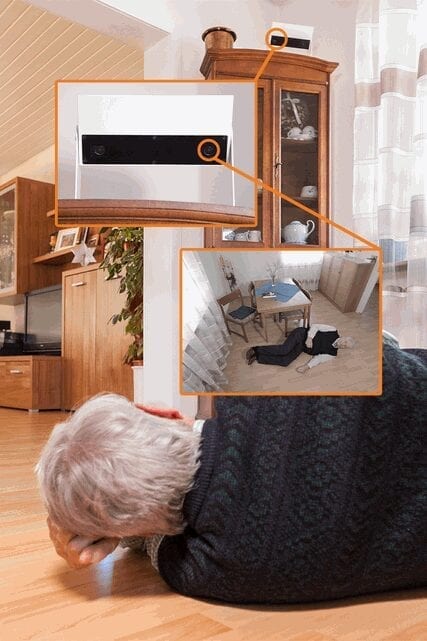
Single seniors lead a risky life: after a fall, they often lie on the floor several hours before their awkward predicament is discovered.
A sensor system detects these emergency situations automatically and sends an emergency signal.
Mr. S. is visually impaired and dependent on a cane since suffering a stroke. Nevertheless, as a 70-yr old living alone, he would rather not move into a care home. Most older people harbor this wish. They want to stay in their own familiar surroundings and continue to live independently for as long as possible. According to data from the German Federal Statistical Office, this applies to 70 percent of seniors. Against better judgment, they are putting their health at risk, for not only does the risk of cardiovascular problems increase with age, but the risk of falling increases also. According to estimates, about 30 percent of those over 65 years of age living at home experience a fall at least once a year. For those over 80 years old, it is more than 40 percent.
Many of the accidents happen during daily housework. However, older persons who are unsure on their feet frequently have accidents at night as well. Often it is hours before they are assisted. They cannot always trigger a domestic emergency device, often called a radio button – because they are not wearing the device, are unconscious, or injured. An emergency alarm like this therefore only offers limited help, just as sensors worn on the body. These sensors react as well to rapid hand movements and are therefore particularly prone to triggering false alarms. Sensors built into the floor no doubt detect emergencies, but they can only be installed through extensive construction at great financial expense.
Maintenance-free and cost-effective emergency system
A system that was maintenance-free, able to detect emergency situations automatically, and could be integrated cost-effectively into every home without restricting the movement of the occupant would be quite helpful. Such a solution, providing safety in every room, is currently under development by researchers at the Fraunhofer Institute for Manufacturing Engineering and Automation IPA using safe@home. The partners in the project are the BruderhausDiakonie, a nonsecular social service foundation in Reutlingen, as well as the Vitracom and Sikom companies. Sensors boxes installed like smoke detectors on the ceiling register when a person falls or needs assistance. If a box detects an emergency situation, it notifies the alarm unit in the home, the CareBox. This unit immediately calls for help – by telephone, cell phone, or internet.
The system works with highly sensitive optical and acoustic sensors that determine the location and condition of a person as well as their movements within a room. The technology uses this data to detect a fall within seconds and identifies a motionless state if no movements are detected within a specific period of time. The system also responds to cries for help. “The occupant is immediately phoned by the CareBox in order to exclude a false alarm. A computer-generated voice asks how they are. The occupant can cancel the alarm by answering. If they fail to answer the phone, safe@home identifies it as an actual emergency,” explains Marius Pflüger, a scientist at IPA in Stuttgart. In this case, family members, neighbors, or care givers are notified. “The sensor boxes, which are about the size of a box of chocolates, operate unobtrusively and automatically. Changing batteries, activating the hardware – none of this is necessary. Privacy is also assured, since the data are evaluated directly in the sensor without having to be stored or transmitted,” says Pflüger.
The Latest on: Independent living
[google_news title=”” keyword=”Independent living” num_posts=”10″ blurb_length=”0″ show_thumb=”left”]
via Google News
The Latest on: Independent living
- Should you avoid living in a 55-plus community? Here are 5 big problems with adult retirement communities in Americaon April 27, 2024 at 3:23 am
T he expression “birds of a feather flock together” leaves plenty of room for, well, ruffling feathers — especially where retirees are concerned. There are plenty of benefits to independent living ...
- The Parkwood: A new premier independent living communityon April 26, 2024 at 1:03 pm
When you reach that golden age of retirement, a world of opportunity & adventure awaits you. But wouldn’t it be nice to do that without all the hassles and responsibilities of owning your ...
- INDEPENDENT LIVING: The People still have a voice!on April 26, 2024 at 2:30 am
As a disability rights advocate for the past 50-some years, I have never been prouder of the way the public responded to the calls for action from Disability Rights advocates ...
- Abundant Christian Living Communityon April 25, 2024 at 7:45 am
Kayla Baker with Abundant Christian Living Community tells us about the independent living community in Johnson City. Phyllis and Jim Pleasant, residents from the community also give us ...
- Providence Place Senior Livingon April 24, 2024 at 3:45 pm
April saw our community enjoying Easter dinner with family and friends. A delicious homemade meal was prepared by our culinary staff with all of Easter’s traditions. The Easter Bunny made ...
- Independent living skills taught in unique training flat launched in regionon April 23, 2024 at 6:00 pm
A charity has opened a training flat in Catterick which is being used to help vulnerable adults practice independent living skills.
- WBAY Cares: Options for Independent Livingon April 23, 2024 at 1:28 pm
Options for Independent Living, a Green Bay area nonprofit, helps families like the Schneiders adjust to a new way of life. “When we think of modifications to help them live more independently, ...
- Senior living as a five-star resorton April 23, 2024 at 9:08 am
Renderings of the courtyard and lobby of the BrightView Senior Living complex, opening in West Harrison in late ...
- Three Pillars Senior Living Communities Breaks Into Active Adult, Expands Offeringson April 22, 2024 at 1:32 pm
This year is shaping up to be a boom for Three Pillars Senior Living Communities, and the remainder of 2024 is looking good for the single-site community.
- 40+ Independent Living Activities: Promoting a Healthy, Fulfilling Retirementon April 22, 2024 at 3:55 am
Key Takeaways Independent living communities are a great option for active seniors. On-site activities can help seniors pursue old and new hobbies. Independent living activities ...
via Bing News









